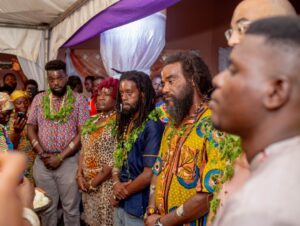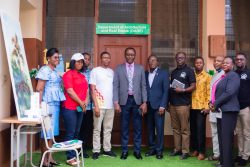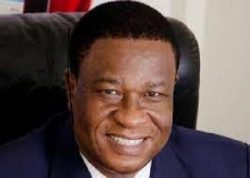As a procession of chiefs and queenmothers makes its way into the inner quarters of the palace in Busua – the traditional capital of Ahanta, the sounds of giant fomtomfrom drums draws onlookers onto the dance floor. The occasion is an august one and the highest level of chiefdom are all present and sitting.

The gathering is to welcome five citizens of the Caribbean Island of Bahamas who have returned to look into their connection with Ahanta – an ethnic group in Ghana’s Western Region.
“We have empirical evidence that the first ever slave ship to have come to the Bahamas came from this part of Africa, specifically, Fort Metal Cross in Dixcove,” says Christopher Davis. Christopher leads an organisation called Sankofa Flamingos Foundation – an activist group that is seeking to trace the roots of the Junkanoo Festival – a street parade with origins from African dance and culture, celebrated largely in the Caribbean and parts of America.

The festival takes its name from a man called Gyan Kwa – a man believed to be a powerful Ghanaian merchant who spent his life fighting the slave trade and European invasion of south western Ghana about 400 years ago. He was a known traditional leader of the Ahanta people and his heroics in between 1708 and 1724, taking over control of the abandoned Brandenburger fortress of Fort Fredericksburg and defending it against several massive conquest attempts of the Dutch.

The history, which was largely documented by European imperialists, is believed to have been written to favour the imperialists. “We are working to correct that and give a proper account of the Junkanoo story from the perspective of the people who matter most”, says Davis.
At the gathering, the overlord of Ahanta – King Badu Bonsoe XIV, speaking through Nana Eziaku IV, the Tufuhen of the Ahanta state, said: “We know there are a lot that binds Ahanta and the diaspora, especially, those in the Caribbean.”

The Sankofa Flamingos Foundation is hoping this trip would help in their research at the ancient town of Princess Town otherwise known as Pokesu. This was the town where Gyan Kwa lived and it was here that he is believed to have built and run his army of around 20,000 men to fight European imperialists until his capture.
“Everything within tells me today that we are home indeed. We have been fed a lot of propaganda about the history of this festival and how it came about and coming here to the land where Gyan Kwa lived and ruled his people mean a lot because we are very sure we will be able to document authentic history and information,” said Angelique McKay, leader of Junkanoo Commandos in the Bahamas.

“At long last, the clouds are moving away and the sun is once again shining on Ahanta. We are gradually coming into the limelight after relegating ourselves to the background for centuries. To have our compatriots from Bahamas tracing their roots to Ahanta tells you that Ahanta has a lot to tell the world,” said Daniel Kwofie, otherwise known as Ahanta Apemenyimheneba Kwofie III, a security analyst and Ahanta history expert.

The team hopes to build a connection between the people and government of Bahamas, and the chiefs and people of Ahanta through strategic connections like a partnership between the Junkanoo festival and the Kundum festival of the Ahanta and Nzema people.










